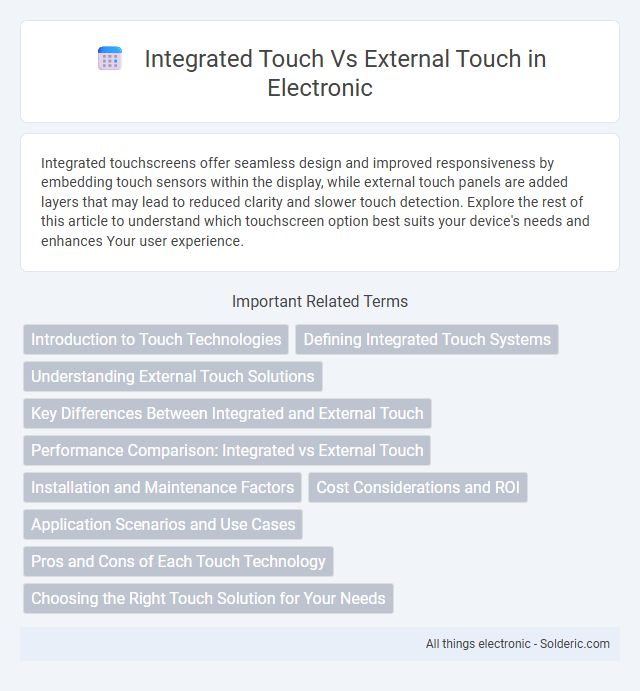Integrated touchscreens offer seamless design and improved responsiveness by embedding touch sensors within the display, while external touch panels are added layers that may lead to reduced clarity and slower touch detection. Explore the rest of this article to understand which touchscreen option best suits your device's needs and enhances Your user experience.
Comparison Table
| Feature | Integrated Touch | External Touch |
|---|---|---|
| Installation | Built into display; no extra setup needed | Separate device; requires connection and setup |
| Portability | Fixed within device; less portable | Flexible and portable |
| Compatibility | Optimized for specific device | Works across multiple devices |
| Durability | Protected within device body | Exposed; may need extra protection |
| Cost | Higher initial manufacturing cost | Lower device cost; extra accessory cost |
| Maintenance | Requires device servicing | Easier replacement or upgrade |
| Performance | Seamless integration; lower latency | Potential latency; varies by model |
Introduction to Touch Technologies
Integrated touch technology combines sensors directly within the display panel, offering enhanced image clarity and reduced device thickness compared to external touch systems, which use separate touch-sensitive layers attached to the screen surface. Capacitive and resistive sensing methods are commonly employed in both technologies, yet integrated touch panels provide superior responsiveness and durability for modern smartphones, tablets, and laptops. Market trends indicate a growing preference for integrated touch solutions driven by advancements in OLED and LCD displays, ensuring seamless user interaction and improved device performance.
Defining Integrated Touch Systems
Integrated touch systems combine touch-sensitive technology directly into the display panel, resulting in thinner, more durable devices with enhanced responsiveness compared to external touch overlays. These systems offer improved clarity and reduced glare by eliminating additional layers, optimizing visual performance for your interactive applications. Choosing integrated touch ensures seamless user interaction and reliable performance in compact, modern devices.
Understanding External Touch Solutions
External touch solutions enhance device flexibility by allowing touch capabilities to be added to existing displays without redesigning the entire screen. These solutions often utilize capacitive or infrared technologies, providing precise touch input while maintaining the original display quality. Their modular nature supports easier upgrades, cost-effective maintenance, and compatibility across various device models and sizes.
Key Differences Between Integrated and External Touch
Integrated touchscreens are built directly into the device's display, offering a sleek design and better durability, while external touch devices are separate peripherals connected to the main system. Integrated touch technology typically provides faster response times and enhanced accuracy due to seamless hardware integration, whereas external touchscreens may introduce latency and require additional setup. Understanding these key differences helps you choose the right solution based on your device's portability, repairability, and user experience needs.
Performance Comparison: Integrated vs External Touch
Integrated touchscreens offer faster response times and lower latency compared to external touch devices due to direct hardware integration and optimized firmware. External touch systems may experience slight input lag and potential signal degradation over connection interfaces like USB or Bluetooth, impacting performance in high-precision tasks. Benchmarks show integrated touch achieves up to 30% quicker touch recognition, making it ideal for gaming and professional design applications.
Installation and Maintenance Factors
Integrated touchscreens feature built-in touch sensors within the display, offering streamlined installation with fewer cables and reduced setup complexity, while external touch overlays require additional mounting and calibration, increasing installation time. Maintenance for integrated touchscreens is generally simpler as the touch function is protected behind a sealed glass surface, reducing exposure to dust and damage, whereas external touch systems may demand frequent cleaning and careful handling to avoid wear and tear. Choosing integrated touch technology can lower long-term maintenance efforts and minimize downtime, ensuring your device remains responsive and reliable.
Cost Considerations and ROI
Integrated touchscreens typically offer lower upfront costs by eliminating the need for separate touch components and reducing installation complexity. External touch solutions can incur additional expenses due to mounting, calibration, and potential compatibility issues, impacting overall ROI negatively. Evaluating long-term maintenance and durability of integrated systems often results in higher return on investment compared to external touch alternatives.
Application Scenarios and Use Cases
Integrated touchscreens are ideal for portable devices like smartphones, tablets, and laptops, offering seamless user interaction and compact design suited for on-the-go applications. External touch monitors serve well in professional settings such as design studios, kiosks, and collaborative workspaces where larger display surfaces and flexibility in positioning are crucial. Your choice between integrated and external touch depends on mobility requirements, workspace setup, and the specific interactive experience needed for the application scenario.
Pros and Cons of Each Touch Technology
Integrated touch technology offers seamless user interaction with devices by embedding touch sensors directly into the display, enhancing responsiveness and reducing device thickness, but it can increase manufacturing costs and complicate repairs. External touch panels provide easier maintenance and can be replaced independently from the display, lowering repair expenses and extending device lifespan, yet they may add thickness and reduce screen clarity due to additional layers. Choosing between integrated and external touch technologies depends on priorities such as device design, maintenance convenience, and overall cost efficiency.
Choosing the Right Touch Solution for Your Needs
Integrated touch screens offer seamless design and enhanced durability by embedding touch sensors directly into the display, making them ideal for sleek devices and high-usage environments. External touch solutions provide flexibility and ease of replacement, allowing for cost-effective upgrades and customization on existing displays. Assessing factors such as device aesthetics, maintenance requirements, and budget constraints is crucial in selecting the optimal touch technology for specific applications.
Integrated Touch vs External Touch Infographic

 solderic.com
solderic.com